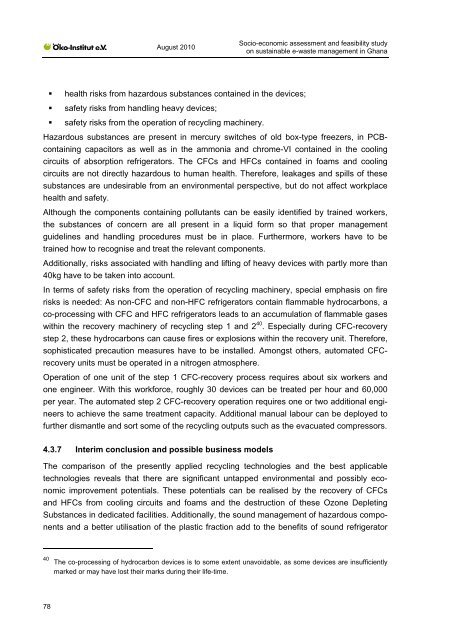Socio-economic assessment and feasibility study on - Öko-Institut eV
Socio-economic assessment and feasibility study on - Öko-Institut eV
Socio-economic assessment and feasibility study on - Öko-Institut eV
You also want an ePaper? Increase the reach of your titles
YUMPU automatically turns print PDFs into web optimized ePapers that Google loves.
78<br />
August 2010<br />
<str<strong>on</strong>g>Socio</str<strong>on</strong>g>-<str<strong>on</strong>g>ec<strong>on</strong>omic</str<strong>on</strong>g> <str<strong>on</strong>g>assessment</str<strong>on</strong>g> <str<strong>on</strong>g>and</str<strong>on</strong>g> <str<strong>on</strong>g>feasibility</str<strong>on</strong>g> <str<strong>on</strong>g>study</str<strong>on</strong>g><br />
<strong>on</strong> sustainable e-waste management in Ghana<br />
� health risks from hazardous substances c<strong>on</strong>tained in the devices;<br />
� safety risks from h<str<strong>on</strong>g>and</str<strong>on</strong>g>ling heavy devices;<br />
� safety risks from the operati<strong>on</strong> of recycling machinery.<br />
Hazardous substances are present in mercury switches of old box-type freezers, in PCBc<strong>on</strong>taining<br />
capacitors as well as in the amm<strong>on</strong>ia <str<strong>on</strong>g>and</str<strong>on</strong>g> chrome-VI c<strong>on</strong>tained in the cooling<br />
circuits of absorpti<strong>on</strong> refrigerators. The CFCs <str<strong>on</strong>g>and</str<strong>on</strong>g> HFCs c<strong>on</strong>tained in foams <str<strong>on</strong>g>and</str<strong>on</strong>g> cooling<br />
circuits are not directly hazardous to human health. Therefore, leakages <str<strong>on</strong>g>and</str<strong>on</strong>g> spills of these<br />
substances are undesirable from an envir<strong>on</strong>mental perspective, but do not affect workplace<br />
health <str<strong>on</strong>g>and</str<strong>on</strong>g> safety.<br />
Although the comp<strong>on</strong>ents c<strong>on</strong>taining pollutants can be easily identified by trained workers,<br />
the substances of c<strong>on</strong>cern are all present in a liquid form so that proper management<br />
guidelines <str<strong>on</strong>g>and</str<strong>on</strong>g> h<str<strong>on</strong>g>and</str<strong>on</strong>g>ling procedures must be in place. Furthermore, workers have to be<br />
trained how to recognise <str<strong>on</strong>g>and</str<strong>on</strong>g> treat the relevant comp<strong>on</strong>ents.<br />
Additi<strong>on</strong>ally, risks associated with h<str<strong>on</strong>g>and</str<strong>on</strong>g>ling <str<strong>on</strong>g>and</str<strong>on</strong>g> lifting of heavy devices with partly more than<br />
40kg have to be taken into account.<br />
In terms of safety risks from the operati<strong>on</strong> of recycling machinery, special emphasis <strong>on</strong> fire<br />
risks is needed: As n<strong>on</strong>-CFC <str<strong>on</strong>g>and</str<strong>on</strong>g> n<strong>on</strong>-HFC refrigerators c<strong>on</strong>tain flammable hydrocarb<strong>on</strong>s, a<br />
co-processing with CFC <str<strong>on</strong>g>and</str<strong>on</strong>g> HFC refrigerators leads to an accumulati<strong>on</strong> of flammable gases<br />
within the recovery machinery of recycling step 1 <str<strong>on</strong>g>and</str<strong>on</strong>g> 2 40 . Especially during CFC-recovery<br />
step 2, these hydrocarb<strong>on</strong>s can cause fires or explosi<strong>on</strong>s within the recovery unit. Therefore,<br />
sophisticated precauti<strong>on</strong> measures have to be installed. Am<strong>on</strong>gst others, automated CFCrecovery<br />
units must be operated in a nitrogen atmosphere.<br />
Operati<strong>on</strong> of <strong>on</strong>e unit of the step 1 CFC-recovery process requires about six workers <str<strong>on</strong>g>and</str<strong>on</strong>g><br />
<strong>on</strong>e engineer. With this workforce, roughly 30 devices can be treated per hour <str<strong>on</strong>g>and</str<strong>on</strong>g> 60,000<br />
per year. The automated step 2 CFC-recovery operati<strong>on</strong> requires <strong>on</strong>e or two additi<strong>on</strong>al engineers<br />
to achieve the same treatment capacity. Additi<strong>on</strong>al manual labour can be deployed to<br />
further dismantle <str<strong>on</strong>g>and</str<strong>on</strong>g> sort some of the recycling outputs such as the evacuated compressors.<br />
4.3.7 Interim c<strong>on</strong>clusi<strong>on</strong> <str<strong>on</strong>g>and</str<strong>on</strong>g> possible business models<br />
The comparis<strong>on</strong> of the presently applied recycling technologies <str<strong>on</strong>g>and</str<strong>on</strong>g> the best applicable<br />
technologies reveals that there are significant untapped envir<strong>on</strong>mental <str<strong>on</strong>g>and</str<strong>on</strong>g> possibly <str<strong>on</strong>g>ec<strong>on</strong>omic</str<strong>on</strong>g><br />
improvement potentials. These potentials can be realised by the recovery of CFCs<br />
<str<strong>on</strong>g>and</str<strong>on</strong>g> HFCs from cooling circuits <str<strong>on</strong>g>and</str<strong>on</strong>g> foams <str<strong>on</strong>g>and</str<strong>on</strong>g> the destructi<strong>on</strong> of these Oz<strong>on</strong>e Depleting<br />
Substances in dedicated facilities. Additi<strong>on</strong>ally, the sound management of hazardous comp<strong>on</strong>ents<br />
<str<strong>on</strong>g>and</str<strong>on</strong>g> a better utilisati<strong>on</strong> of the plastic fracti<strong>on</strong> add to the benefits of sound refrigerator<br />
40<br />
The co-processing of hydrocarb<strong>on</strong> devices is to some extent unavoidable, as some devices are insufficiently<br />
marked or may have lost their marks during their life-time.

















